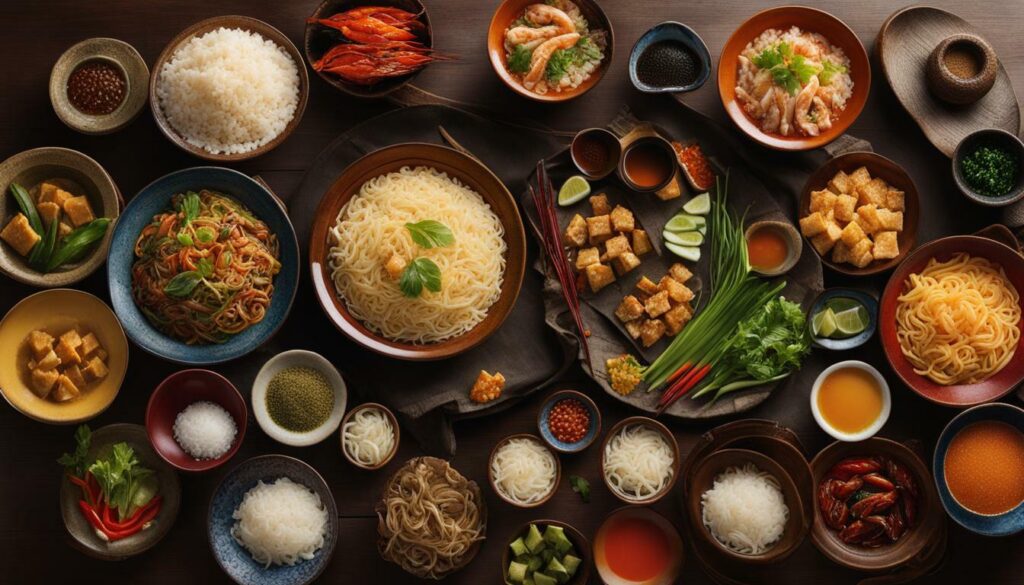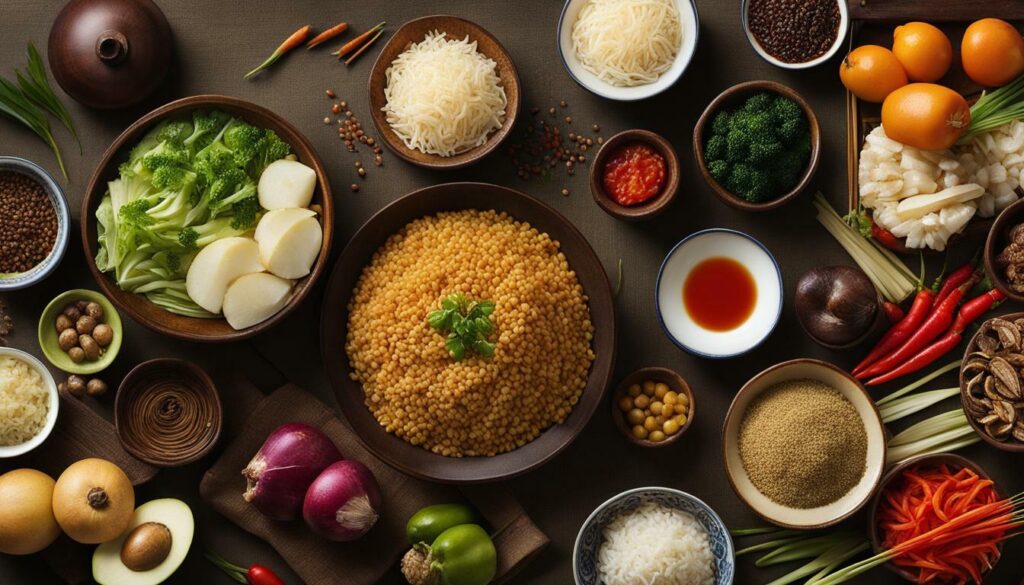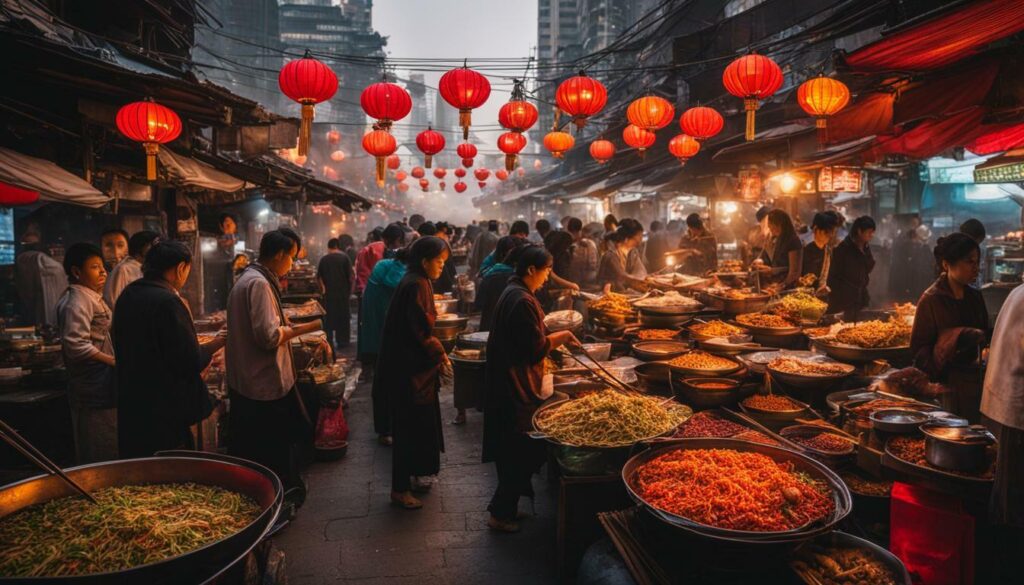East Asia has a rich history of culinary traditions that have evolved over time, shaping the past and present diets of the region. The history of food in East Asia is a fascinating tapestry of flavours, ingredients, and cooking techniques that have been passed down through generations. From the ancient civilizations of China, Japan, and Korea to the modern-day cuisines of these countries and more, East Asian cuisine has a rich and diverse heritage.
Key Takeaways:
- East Asian cuisine has a long and storied history, with culinary traditions that have been shaped by centuries of cultural influences.
- Traditional foods play a crucial role in East Asian diets, with staple ingredients such as rice, noodles, and grains providing the foundation for many dishes.
- The evolution of East Asian diets can be traced through the introduction of new ingredients, cooking techniques, and cultural influences that have shaped the region’s culinary landscape.
- Understanding dietary acculturation in East Asian immigrant populations is important for addressing the increased risk of chronic diseases in these communities.
- Central Asia has had a profound impact on the modern world through ancient trade routes, influencing the spread of agricultural practices and the foods we eat today.
The Influence of Cultural Traditions on East Asian Diets
The diets of East Asia have been heavily influenced by the region’s rich culinary traditions, with traditional recipes and foods playing a significant role in shaping the cuisine. Culinary traditions in East Asia have been passed down through generations, preserving ancient cooking techniques and flavour profiles that continue to be enjoyed today. Traditional East Asian recipes are cherished for their cultural significance and the unique flavours they offer.
Traditional East Asian foods encompass a wide variety of ingredients and flavours, reflecting the diverse landscapes and cultural heritage of the region. From the delicate sushi of Japan to the fiery kimchi of Korea, each country in East Asia has its distinct culinary tradition. These traditional foods not only satisfy hunger but also serve as a source of pride and identity for the people of East Asia.
Understanding and appreciating the East Asian culinary tradition goes beyond just enjoying delicious dishes. It provides insight into the history and cultural heritage of the region. The preparation and consumption of traditional East Asian recipes bring communities together, fostering a sense of unity and shared identity. The flavours and techniques passed down through generations connect the past with the present, creating a rich tapestry of culinary traditions that continue to evolve and thrive.

Traditional East Asian recipes encompass a wide range of dishes and cooking styles. From the delicate and intricate flavours of Chinese dim sum to the bold and savoury flavours of Korean barbecue, there is something for everyone in East Asian cuisine. Each country has its unique recipes and ingredients that are celebrated for their taste and cultural significance.
| Country | Signature Dish |
|---|---|
| China | Peking Duck |
| Japan | Sushi |
| Korea | Bibimbap |
These are just a few examples of the diverse and delicious traditional recipes found in East Asia. Whether it’s the bold flavours of Sichuan cuisine or the delicate artistry of Japanese tea ceremonies, each dish tells a story and reflects the cultural heritage of the region.
The Evolution of East Asian Diets
The diets of East Asia have undergone significant changes over the centuries, with evolving culinary practices and the introduction of new ingredients shaping the cuisine we see today. From traditional dishes that have stood the test of time to modern adaptations influenced by globalization, East Asian diets are a reflection of the region’s rich history and cultural diversity.
Historically, East Asian cuisines have been characterized by their emphasis on balance, harmony, and the use of fresh, seasonal ingredients. Traditional staple foods such as rice, noodles, and various grains have provided sustenance and energy for generations. However, as trade and cultural exchange expanded, so did the culinary repertoire of East Asian cuisines.
The introduction of new ingredients, spices, and cooking techniques from neighbouring regions and beyond brought about a culinary revolution in East Asia. From the tangy flavours of Sichuan cuisine to the delicate artistry of Japanese sushi, the region’s cuisines have continued to evolve and adapt to changing tastes and preferences.
Today, East Asian cuisines have gained global popularity, with dishes such as Chinese stir-fries, Korean barbecue, and Japanese ramen becoming beloved staples in many countries. These popular dishes represent the fusion of traditional flavours with modern culinary innovation, capturing the essence of East Asian cuisine in a contemporary context.
Popular East Asian Dishes
When it comes to popular East Asian dishes, there is a wide variety to choose from. Here are just a few examples:
- Chinese sweet and sour chicken
- Japanese sushi and sashimi
- Korean bibimbap
- Thai green curry
- Vietnamese pho
These dishes showcase the diversity and culinary excellence of East Asian cuisines, offering a glimpse into the vibrant flavours and culinary traditions of the region.

| Historical Period | Key Changes |
|---|---|
| Ancient Times | Development of staple foods like rice and noodles |
| Medieval Period | Introduction of new ingredients and spices through trade |
| Modern Era | Globalization and fusion of cuisines from around the world |
Traditional East Asian Diets and Nutrition
Traditional East Asian diets are not only rich in cultural significance but also offer a range of nutritional benefits, reflecting the food culture and dietary practices of the region. East Asian food culture revolves around the principles of balance, harmony, and moderation. With a focus on fresh, seasonal ingredients, these diets are known for their high content of vegetables, fruits, and grains.

The East Asian food culture emphasizes the consumption of a variety of plant-based foods, such as rice, noodles, tofu, soybeans, seaweed, and a wide array of vegetables. These foods provide essential nutrients, vitamins, and minerals necessary for maintaining good health. The traditional diet is also low in saturated fats and cholesterol, which contributes to better heart health and a reduced risk of chronic diseases.
Furthermore, the cooking methods used in East Asian cuisine, such as steaming, stir-frying, and boiling, help to preserve the natural flavours and nutrients of the ingredients. This ensures that the food retains its nutritional value while offering a delightful taste experience.
East Asian Dietary Practices and Rituals
- Tea ceremonies: East Asian cultures have a long-standing tradition of tea ceremonies, where the preparation and consumption of tea are seen as an art form. This practice promotes mindfulness and a sense of calm while enjoying the health benefits of tea.
- Sharing meals: In East Asian societies, communal dining is a common practice, with dishes being placed in the centre of the table for everyone to share. This fosters a sense of togetherness and encourages social interaction.
- Eating seasonally: East Asian diets prioritize the consumption of seasonal foods, as they are believed to be fresher, tastier, and more nutritious. This practice aligns with the principles of balance and harmony.
Overall, traditional East Asian diets offer a well-rounded approach to nutrition, incorporating a diverse range of ingredients and cooking techniques. By embracing the food culture and dietary practices of the region, individuals can not only enjoy delicious meals but also reap the health benefits that have been passed down through generations.
| Nutrient | Examples | Health Benefits |
|---|---|---|
| Antioxidants | Green tea, red beans, goji berries | Reduce free radicals, support immune function |
| Fiber | Whole grains, fruits, vegetables | Promote digestive health, prevent constipation |
| Omega-3 fatty acids | Fish, seaweed, flaxseeds | Support brain health, reduce inflammation |
| Probiotics | Miso, kimchi, yogurt | Improve gut health, enhance immune function |
Staple Foods in East Asia
Staple foods such as rice and noodles are integral to East Asian diets, providing a source of sustenance and energy. These dietary staples have been a part of the region’s culinary traditions for centuries and continue to play a significant role in the daily lives of East Asian people.
Rice, in particular, holds a special place in East Asian cuisine. It is a versatile grain that can be prepared in various ways, from steamed rice to sushi and rice noodles. Rice fields are a common sight across East Asia, reflecting the esteem in which this staple food is held.
Noodles, on the other hand, come in a wide variety of forms, including wheat, rice, and buckwheat noodles. They are used in a multitude of dishes, such as stir-fries, soups, and cold noodle salads. Each country in East Asia has its own unique noodle dishes, showcasing the diversity and creativity of the region’s cuisine.
In addition to rice and noodles, other grains like millet and barley are also consumed in East Asia, although to a lesser extent. These grains are often used in porridges or mixed with rice to add nutritional value and texture to meals.
The Role of Staple Foods in East Asian Culture
Staple foods in East Asia go beyond their nutritional value and have deep cultural significance. They are closely associated with family meals, festivities, and community gatherings. These foods are often prepared with care and shared among loved ones, fostering a sense of unity and togetherness.
Furthermore, the tradition of rice cultivation has shaped East Asian agricultural practices and landscapes. Rice terraces, such as those found in China and the Philippines, are not only visually stunning but also a testament to the sustainable farming methods developed over centuries.
Overall, staple foods like rice and noodles are not only nourishing and flavorful, but they also embody the rich cultural heritage of East Asia. They are a testament to the region’s culinary traditions and a source of pride for its people.

| Country | Staple Food |
|---|---|
| China | Rice |
| Japan | Noodles (e.g., soba, udon) |
| Korea | Rice |
| Thailand | Rice |
As seen in the table above, rice remains a staple food across East Asian countries, reflecting its importance in the region’s cuisine. However, each country also has its own unique twist on staple foods, showcasing the culinary diversity that exists within East Asia.
Historical Diets in East Asia
Understanding the historical diets of East Asia provides valuable insights into the food choices and culinary traditions of past civilizations. Factual data has shown that the origin and evolution of modern humans in East Asia have been of scientific interest, with diet playing a crucial role in human adaptation. One method of reconstructing past diets is through the analysis of dental calculus, which contains valuable dietary information. Starch grain analysis from dental calculus has revealed plant food exploitation strategies from East Asian sites like Zhuannian, Nanzhuangtou, and Shizitan.
In order to further our understanding, researchers are now focusing on starch grains from dental calculus of human teeth dating back 120-80 ka from Fuyan Cave in South China. By studying these starch grains, they hope to gain insights into the subsistence strategies and adaptations of early modern humans in the region. This research aims to shed light on the dietary practices that shaped the lives of our ancestors in East Asia thousands of years ago.

Exploring the historical diets of East Asia not only offers a glimpse into the past but also highlights the impact of culinary traditions on present-day food choices. It is fascinating to see how certain foods and cooking techniques have been passed down through generations, shaping the rich and diverse cuisines we enjoy today. The globalization of agriculture, driven in part by ancient trade routes like the Silk Road, also played a significant role in the diffusion of crops across Central Asia, ultimately influencing the food cultures of Asia, Europe, and North Africa.
Modern Day Cuisines in East Asia
East Asia is home to a diverse range of modern-day cuisines, each with its own distinct flavours and dishes. From the savoury flavours of Chinese cuisine to the delicate and artful presentations of Japanese dishes, the culinary landscapes of East Asian countries are a feast for the senses.

The rich cultural heritage of East Asia is reflected in its cuisine, with traditional recipes and cooking techniques passed down through generations. In China, for example, regional cuisines such as Sichuan, Cantonese, and Shanghainese offer a wide range of flavours and ingredients that cater to different tastes. Japan’s cuisine, known for its emphasis on fresh and seasonal ingredients, showcases the country’s commitment to preserving culinary traditions.
Korea, known for its fiery and flavorful dishes, combines ingredients like kimchi, soy sauce, and gochujang to create a unique taste profile. Other countries in East Asia, such as Vietnam, Thailand, and Malaysia, also contribute to the diverse culinary tapestry of the region with their own distinctive flavours and cooking styles.
Whether you’re savouring a bowl of rich and aromatic pho in Vietnam, indulging in a plate of sushi in Japan, or enjoying the tangy and spicy flavours of a Korean barbecue, the modern-day cuisines of East Asia offer an unparalleled gastronomic experience. Exploring these flavours and dishes allows us to appreciate the richness of East Asian culinary traditions and the cultural significance of food in the region.
Dietary Acculturation in East Asian Immigrant Populations
East Asian immigrant populations often experience changes in dietary practices and eating patterns as they adapt to their new environments, a phenomenon known as dietary acculturation. The adoption of the host country’s food and eating habits can have significant effects on the health and well-being of these immigrant populations. Understanding the impact of dietary acculturation is crucial for addressing the increased risk of diseases such as diabetes and cardiovascular disease that East Asian immigrants face in their destination countries.
Research on dietary acculturation in East Asian immigrant populations has primarily relied on self-reported cross-sectional surveys to assess changes in diet since immigration. While these studies provide valuable insights, there is a need for more comprehensive and rigorous measures to accurately capture the complex nature of dietary acculturation. Longitudinal studies using prospective measures of diet change can provide a deeper understanding of the relationship between dietary acculturation and disease risk.
Qualitative studies, such as interviews and focus groups, have also shed light on the experiences of East Asian immigrants and their dietary acculturation. These studies explore the socio-cultural factors that influence food choices, as well as the challenges faced by immigrants in maintaining traditional dietary practices. By combining qualitative and quantitative approaches, researchers can gain a holistic understanding of the impact of dietary acculturation on health outcomes.
Developing effective interventions to promote healthy eating habits and mitigate the negative health effects of dietary acculturation requires a comprehensive understanding of the factors influencing food choices among East Asian immigrants. By acknowledging the unique challenges and experiences faced by these populations, healthcare professionals and policymakers can develop culturally appropriate strategies to support the maintenance of healthy dietary practices and improve the overall well-being of East Asian immigrants.
| Key Points: | East Asian Dietary Practices, Evolution of East Asian Diets |
|---|---|
| Summary: | East Asian immigrant populations often undergo dietary acculturation, adopting the food and eating habits of their destination countries. Understanding the implications of dietary acculturation and developing comprehensive measures to assess its impact are crucial for addressing the increased risk of diseases such as diabetes and cardiovascular disease in these populations. |
Conclusion
In conclusion, the past and present diets of East Asia have been shaped by rich culinary traditions, evolving tastes, and cultural influences, offering a unique and diverse food culture in the region. Throughout history, the cuisines of East Asia have evolved as a result of the introduction of new ingredients, cooking techniques, and cultural exchanges. Traditional foods have played a significant role in shaping the culinary traditions of East Asia, with staple foods like rice and noodles forming the foundation of many dishes.
The cultural traditions of East Asia have also had a profound influence on the region’s diets. From traditional recipes that have been passed down through generations to the significance of the East Asian culinary tradition, cultural influences are deeply ingrained in the food choices and dietary practices of the region. These traditions have not only provided sustenance but have also contributed to the nutritional aspects of East Asian diets.
Moreover, the modern-day cuisines of East Asia continue to showcase the rich culinary landscapes of countries such as China, Japan, Korea, and others. Each cuisine offers unique dishes and flavours that reflect the diverse history and cultural heritage of the region. From classic dishes to innovative creations, East Asian cuisines continue to delight food enthusiasts around the world.
Understanding the concept of dietary acculturation in East Asian immigrant populations is crucial in addressing the health risks they may face. The adoption of the host country’s food and eating patterns can have an impact on disease risk. Further research is needed to develop comprehensive tools that can effectively measure dietary acculturation and its relationship with health outcomes in East Asian immigrant populations.
FAQ
What is the significance of studying the past diets of East Asia?
Studying past diets can provide insights into human adaptation and physiology, as well as reveal strategies and adaptations of early modern humans in the region.
How is dietary acculturation measured in East Asian immigrant populations?
Most studies use self-reported cross-sectional surveys to determine changes in diet since immigration. Only a few longitudinal studies use prospective measures of diet change. Qualitative studies have explored dietary acculturation through interviews and focus groups.
What impact did Central Asia have on the modern world?
Central Asia had a profound impact on the modern world through ancient exchange routes, such as the Silk Road. Many familiar grains, fruits, legumes, and nuts spread through Central Asia and shaped our modern diets.
Source Links
- https://www.ucpress.edu/blog/45550/the-silk-road-origins-of-the-foods-we-eat/
- https://www.frontiersin.org/articles/10.3389/fpls.2022.989308
- https://www.ncbi.nlm.nih.gov/pmc/articles/PMC8166541/



